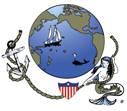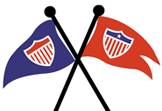South Pacific Schedule
Most people don't
fully appreciate that crossing the South Pacific usually requires a very real schedule
in order to maximize your time and still avoid the South Pacific cyclones.
We certainly didn't, which is why we're writing this page. Cruisers hate
schedules, but to avoid the South Pacific Cyclone Season - usually November through April -
you need to be out of the South Pacific and safely in either New Zealand,
Australia, or north of
about 5° South latitude by November. Although cyclones can
strike in any month (and often do in the North Pacific) there are definite
seasons of higher and lower probability that can usually be counted on.
These (and a bit of bureaucracy) are the main forces driving schedules in the
South Pacific.
As you can read from the South Pacific Weather
page, the cyclone "box" extends from just west of the
Society Islands of French Polynesia west to Australia, and from about 5 degrees
south to about 30 degrees south latitude. The nominal South Pacific
cyclone season extends from about November through April, so the safe cruising season
goes from May through October.
The best way to work out the first part of a South Pacific schedule is to work backwards.
The following example assumes a cruise starting in Panama and continuing through
the Galapagos, the Marquesas and Society islands of French Polynesia.
French Polynesia is usually safe from cyclones unless it's an "El Niño"
year. Therefore, to maximize time in the rest of the Pacific, boats should
be ready to sail west out of the
Society Islands
of French Polynesia by early May. Since most
non-European Union citizens only get 3 months in French Polynesia, to
maximize your time in French Polynesia you want to arrive in the
Marquesas
near the beginning of February.
This will allow you to spend February, March, and April in French Polynesia.
Note: There are some alternative ways to extend your time
in French Polynesia. For example, in 2004 we were told by officials in
Papeete that we
had to clear out of French Polynesia in Tahiti.
When we complained that we still wanted to cruise the Society Islands west of
Tahiti, they said that was fine - we could cruise there as long as we
liked! This let us stay much longer than the 3 months we were
nominally allowed, but we're not at all sure this policy can be depended on.
Don't even think about the French "long-stay" visa - it's expensive
and almost impossible to get (we tried - they sent our paperwork to Martinique!).
Also, since boats can stay in French Polynesia for a full
year before they have to be imported (it's only the people who are limited to
3 months) some folks chose to haul their boats in Raiatea and leave
them on the hard while they went back home. We did something like
this in order to extend our stay in the delightful French isles.
Other cruisers simply flew somewhere like Easter Island, as their 3 month
clock started all over again when they returned to French Polynesia.
|
The trip from the Galapagos to the Marquesas covers almost 3,000 miles.
Most boats take 3-4 weeks to cover this distance, so that means leaving the
Galapagos sometime in early January. Since most boats will want to spend
their full month in the Galapagos, they should plan to arrive there in early
December. (Actually, boats are currently only allowed 21 days in the
Galapagos, but everyone clears out from Puerto Ayora and then spends another
week or so in Isabela, as the officials there don't seem to care).
Computation of a Cruising Schedule
| Location |
Time |
Start |
End |
| San Blas |
30 days |
early Oct |
early Nov |
| Panama Canal |
14 days |
early Nov |
late Nov |
| Sail to Galap |
8 days |
late Nov |
early Dec |
| Galapagos |
28 days |
early Dec |
early Jan |
| Sail Galap to FP |
3-4 weeks |
early Jan |
early Feb |
| French Polynesia |
3 months |
early Feb |
early May |
|
Most boats will want to spend at least a month in the
San Blas Islands on the
Caribbean side of Panama. Getting through the
Canal only
takes 1-2 days, but it usually takes a couple weeks to arrange everything.
Also, Panama is virtually the last place boats can get good work done until New
Zealand or Australia. Yes, there are slipways in Tahiti, Raiatea, Tonga,
Fiji, and New Caledonia, but little in the way of supplies or expertise, and
you'll pay dearly for what you get. So the best bet is to get what you
need done in Panama, and time for that needs to be accounted for. Bottom
line - cruisers coming from the Caribbean should really
plan to arrive in the San Blas by early October!
Since this is still the tail end of the Caribbean hurricane season, cruisers
will want to take suitable precautions, probably by cruising hurricane-safer
Venezuela, the ABCs, and/or Colombia before heading for the San Blas.
A note on Ecuador - most boats head directly to the Galapagos from Panama and
end up beating their brains out for 8-10 days. We decided to break the
trip into 2 legs by going via mainland Ecuador instead, taking 4 days for each
leg. This also allowed us to take a delightful trip into the Andes of
inland Ecuador, where
we were able to live like kings due to the favorable prices there. On the
trip down from Panama
we were able to fly the spinnaker for the first few days. Only the last
day getting into Manta was close-hauled, and that was only into a gentle
10 knots. The leg from
Manta to Cristobal
had the wind forward of the beam but only close-reaching into 10-15 knots - both
very pleasant passages, and much better than reports we heard of the direct route
from Panama.
By May the tradewinds west of French Polynesia should have established themselves
and conditions across the South Pacific should have stabilized. Only then should
cruisers jump off from Bora-Bora to head for the Cook Islands, Niue, Samoa, Tonga, Fiji,
Vanuatu, Solomon Islands, and New Caledonia. However, the clock is still
ticking - By November, cruisers need a way to deal with the coming cyclone
season. The ways to avoid cyclones in the South Pacific are:
- Don't leave French Polynesia until cyclone season has ended (usually May)
- Stay within about 5 degrees of the equator (but there's not much up there)
- Be in New Zealand (most common) or Australia by November (but that means moving quickly)
- Leave the boat in a "cyclone-safe" area for the cyclone season
|
By November, most cruising boats have gone down
to New Zealand for cyclone season. They sail down from Tonga or Fiji or
wherever they've got to, and then they sail back up after cyclone season to resume
their cruise across the Pacific. Some cruisers do this for several seasons.
But even that plan has problems. New Zealand in the summer is gorgeous and
the Kiwi's are friendly, but the trip down from Tonga or Fiji or even New Caledonia
is a nasty 1,200 mile passage and most boats get beat-up either
going down or coming back up. The problem is that, while the tradewinds blow
from the SE, low and high pressure systems move west to east,
alternating about every 4 days. Since the trip typically takes about
8 days, boats are likely to get clobbered by one of these systems. In 2005
the fleet coming north got clobbered by an intense, fast-moving "bullet-low".
Three boats were abandoned at sea, one broke its anchor chain in Minerva Reef
and was lost on the rocks, and a Japanese single-hander ran into Minerva Reef
while he slept. We were off Lautoka, Fiji when the low went through
(predictably at 2:30am). First we dragged our mooring and then we had to rescue a
46' (14m) sloop that had dragged onto the Bekana reef.
There aren't many areas that I'd consider "cyclone-safe" but lots of boats
spent the season in Fiji, as we did. Some took "cyclone moorings" in
Savusavu (US$90/month in 2005) but they didn't seem very safe to me, and after
just 2 days in Savusavu you've pretty much seen all there is to see. Other
boats went to Vuda (pronounced Vunda) Point Marina just south of Lautoka and had
their boats hauled out and put into holes scooped into the ground. This
seemed relatively safe, but again, there's not much to do in Vuda Point but swat
mosquitoes. We cruised through the
Mamanuca and
Yasawa Islands, which was
wonderful, but we were the only cruising boat moving around. We kept
a close eye on the weather and always knew where our 4 closest cyclone-holes
were, but after all was said and done, we were lucky.
There are certainly different ways to arrange this schedule -
for instance, cruisers from the European Union can stay in
French Polynesia
for 1 year, which makes planning a bit easier - but the Pacific definitely
needs some thought. Feel free to contact us
if you want more of an explanation and some other options.
Pacific Cruising Info:
Up | South Pacific Weather | South Pacific Schedule | Panama Transit | Cruising Galapagos | Cruising Marquesas | Tonga-Fiji Hazards | Cruising Fiji | Australian Arrival | Cruising Australia | Cruising Solomons | Cruising PNG | Cruising Philippines
Cruising Info:
General Cruising Info | Equipment | Pacific Ocean Cruising | Indian Ocean Cruising | Provisioning Food & Fuel | Cruising Recipes
Top Level:
Home |
Destinations |
Cruising Info |
Underwater |
Boat Guests |
Ocelot |
Sue |
Jon |
Amanda |
Chris |
Site Map |
Make a Comment
 |
Lifetime
Commodores
of the
Seven Seas
Cruising
Association |
 |
|
If our information is useful,
you can help by making a donation
|
Copyright © 2000‑ Contact:
Jon and Sue Hacking -- HackingFamily.com, svOcelot.com.
All rights reserved.

